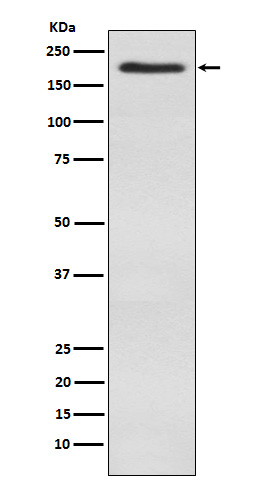Anti-WSTF Rabbit Monoclonal Antibody
- SPECIFICATION
- CITATIONS
- PROTOCOLS
- BACKGROUND

Application
| WB, FC |
|---|---|
| Primary Accession | Q9UIG0 |
| Host | Rabbit |
| Isotype | IgG |
| Reactivity | Rat, Human, Mouse |
| Clonality | Monoclonal |
| Format | Liquid |
| Description | Anti-WSTF Rabbit Monoclonal Antibody . Tested in WB, Flow Cytometry applications. This antibody reacts with Human, Mouse, Rat. |
| Gene ID | 9031 |
|---|---|
| Other Names | Tyrosine-protein kinase BAZ1B, 2.7.10.2, Bromodomain adjacent to zinc finger domain protein 1B, Williams syndrome transcription factor, Williams-Beuren syndrome chromosomal region 10 protein, Williams-Beuren syndrome chromosomal region 9 protein, hWALp2, BAZ1B, WBSC10, WBSCR10, WBSCR9, WSTF |
| Calculated MW | 185 kDa |
| Application Details | WB 1:500-1:2000 FC 1:50 |
| Contents | Rabbit IgG in phosphate buffered saline, pH 7.4, 150mM NaCl, 0.02% sodium azide and 50% glycerol, 0.4-0.5mg/ml BSA. |
| Clone Names | Clone: 19B23 |
| Immunogen | A synthesized peptide derived from human WSTF |
| Purification | Affinity-chromatography |
| Storage | Store at -20°C for one year. For short term storage and frequent use, store at 4°C for up to one month. Avoid repeated freeze-thaw cycles. |
| Name | BAZ1B |
|---|---|
| Synonyms | WBSC10, WBSCR10, WBSCR9, WSTF |
| Function | Atypical tyrosine-protein kinase that plays a central role in chromatin remodeling and acts as a transcription regulator (PubMed:19092802). Involved in DNA damage response by phosphorylating 'Tyr-142' of histone H2AX (H2AXY142ph) (PubMed:19092802, PubMed:19234442). H2AXY142ph plays a central role in DNA repair and acts as a mark that distinguishes between apoptotic and repair responses to genotoxic stress (PubMed:19092802, PubMed:19234442). Regulatory subunit of the ATP-dependent WICH-1 and WICH-5 ISWI chromatin remodeling complexes, which form ordered nucleosome arrays on chromatin and facilitate access to DNA during DNA-templated processes such as DNA replication, transcription, and repair (PubMed:11980720, PubMed:28801535). Both complexes regulate the spacing of nucleosomes along the chromatin and have the ability to slide mononucleosomes to the center of a DNA template (PubMed:28801535). The WICH-1 ISWI chromatin remodeling complex has a lower ATP hydrolysis rate than the WICH-5 ISWI chromatin remodeling complex (PubMed:28801535). The WICH-5 ISWI chromatin-remodeling complex regulates the transcription of various genes, has a role in RNA polymerase I transcription (By similarity). Within the B-WICH complex has a role in RNA polymerase III transcription (PubMed:16603771). Mediates the recruitment of the WICH-5 ISWI chromatin remodeling complex to replication foci during DNA replication (PubMed:15543136). |
| Cellular Location | Nucleus {ECO:0000255|PROSITE-ProRule:PRU00063, ECO:0000255|PROSITE-ProRule:PRU00475, ECO:0000269|PubMed:11980720, ECO:0000269|PubMed:15543136, ECO:0000269|PubMed:16603771, ECO:0000269|PubMed:25593309}. Note=Accumulates in pericentromeric heterochromatin during replication (PubMed:15543136). Co-localizes with PCNA at replication foci during S phase (PubMed:15543136). Co-localizes with SMARCA5/SNF2H at replication foci during late-S phase (PubMed:15543136). Also localizes to replication foci independently of SMARCA5/SNF2H and PCNA (PubMed:15543136). Localizes to sites of DNA damage (PubMed:25593309). |
| Tissue Location | Ubiquitously expressed with high levels of expression in heart, brain, placenta, skeletal muscle and ovary |

Thousands of laboratories across the world have published research that depended on the performance of antibodies from Abcepta to advance their research. Check out links to articles that cite our products in major peer-reviewed journals, organized by research category.
info@abcepta.com, and receive a free "I Love Antibodies" mug.
Provided below are standard protocols that you may find useful for product applications.
If you have used an Abcepta product and would like to share how it has performed, please click on the "Submit Review" button and provide the requested information. Our staff will examine and post your review and contact you if needed.
If you have any additional inquiries please email technical services at tech@abcepta.com.













 Foundational characteristics of cancer include proliferation, angiogenesis, migration, evasion of apoptosis, and cellular immortality. Find key markers for these cellular processes and antibodies to detect them.
Foundational characteristics of cancer include proliferation, angiogenesis, migration, evasion of apoptosis, and cellular immortality. Find key markers for these cellular processes and antibodies to detect them. The SUMOplot™ Analysis Program predicts and scores sumoylation sites in your protein. SUMOylation is a post-translational modification involved in various cellular processes, such as nuclear-cytosolic transport, transcriptional regulation, apoptosis, protein stability, response to stress, and progression through the cell cycle.
The SUMOplot™ Analysis Program predicts and scores sumoylation sites in your protein. SUMOylation is a post-translational modification involved in various cellular processes, such as nuclear-cytosolic transport, transcriptional regulation, apoptosis, protein stability, response to stress, and progression through the cell cycle. The Autophagy Receptor Motif Plotter predicts and scores autophagy receptor binding sites in your protein. Identifying proteins connected to this pathway is critical to understanding the role of autophagy in physiological as well as pathological processes such as development, differentiation, neurodegenerative diseases, stress, infection, and cancer.
The Autophagy Receptor Motif Plotter predicts and scores autophagy receptor binding sites in your protein. Identifying proteins connected to this pathway is critical to understanding the role of autophagy in physiological as well as pathological processes such as development, differentiation, neurodegenerative diseases, stress, infection, and cancer.


